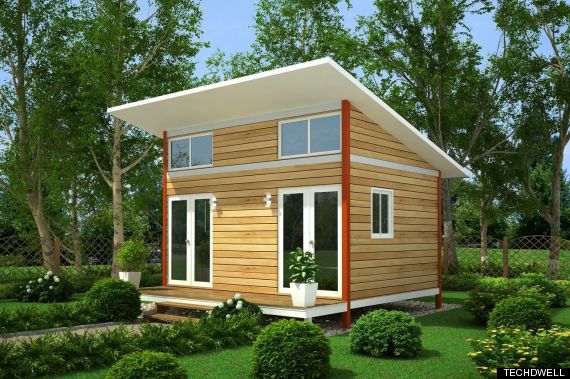So a facebook friend shared an article about a plan to build microhouses for the homeless in Portland, Oregon, from the Huffington Post, of course. The article quotes a homeless woman: “It’s exciting. I’ve never owned my own house” — but in reality, the 12 x 16, 192-square foot houses would be built on city-owned land, managed by a non-profit, and rented out for $250 – $350 per month.
What would the houses be like? According to the article that the Huffington Post links to, from OregonLive.com,
[They] would cost roughly $12,000 each to build, Carboneau said, plus another few thousand dollars a piece to hook up sewer and electricity.
Each unit could house two single adults. Each would be equipped with a bathroom, small kitchen and a futon couch that converts into a bed for sleeping. The units could be adjusted to accommodate families or other living arrangements, Carboneau said.
Which raises the first question of how two single adults would be expected to share the same bed. One hopes that the projected rent is per unit, and the “two single adults” really just means that a couple could share the house. Is the house size too small to be habitable? Plenty of people have lived in smaller accomodations, I suppose.
Is this sustainable? Is the rent specified affordable for the very poor, and yet enough to adequately fund the project (aside from the fact that the land is to be given free)? That’s not addressed in the article. But there’s yet another link, to a description of how the houses, manufactured by a firm called TECHDWELL (yes, all caps), are built to begin with.
The kicker? The example house is in Haiti. No sewer hook-up, because the toilet is “compostable.” No plumbing hook-up, either, from what I can tell, though there is a sink and a shower, so perhaps there’s a water tank connection? No electrical connection — the article says “Lighting fixtures are wireless, eliminating the need for skilled electrical work.” (What does this mean? Battery-powered lights? No power supply at all? That’s not going to fly in the U.S.) And on top of this, the example house isn’t particularly weather-proofed, and, it being Haiti, there’s no heating, let alone air conditioning.
Now, if it hasn’t occurred to you already, we already have a fairly well-developed form of micro-house in the U.S., appropriate for American standards of living: the mobile/manufactured home. Around here, the starting price seems to be about $10,000, for an older unit (lot not included, of course). How small do/could they get? I’m not sure. Would it be remotely as cost-efficient as a multi-unit building with small studio units, with common areas for recreation and cooking (e.g., a SRO)? That’s hard to imagine, especially when considering the cost of heating and building maintenance is taken into account — especially if you keep in mind the issue of opportunity cost: the city is planning on giving vacant land to this non-profit builder, that it could otherwise sell or use for another purpose. It’s not causing land to appear out of nowhere. And consider that the plan is for these houses to be built in groupings of 25 — but you could build a lot more on less land, if it were multi-unit.
In other words, this is a very expensive way to help a small number of homeless, with a fair portion of the cost invisible (the “free” land) and no sort of tallying of costs at all. Or, bait-and-switch.













